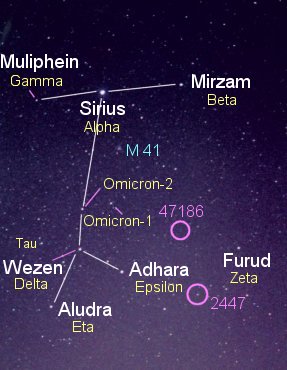 HR 2447 has not one, but two planets. More unusual, like HR 2877, the planet belong not to an
ordinary dwarf, as most do, but to a giant star, one that is in the
act of evolving and dying.
HR 2447 has not one, but two planets. More unusual, like HR 2877, the planet belong not to an
ordinary dwarf, as most do, but to a giant star, one that is in the
act of evolving and dying.
THE PLANETS
The lower circle shows the location of the class K giant star HR
2447, found in the constellation Canis
Major. The planets orbit their star with periods of 430 and
2500 days (1.18 and 6.84 years) and average orbital sizes of 1.1
and 3.5 Astronomical Units, the inner one with an eccentricity of
about 20 percent. Lower limits to the masses are respectively
estimated at 5 and 7 times that of Jupiter.
|
 HR 2447 has not one, but two planets. More unusual, like HR 2877, the planet belong not to an
ordinary dwarf, as most do, but to a giant star, one that is in the
act of evolving and dying.
HR 2447 has not one, but two planets. More unusual, like HR 2877, the planet belong not to an
ordinary dwarf, as most do, but to a giant star, one that is in the
act of evolving and dying.
 HR 2447 has not one, but two planets. More unusual, like HR 2877, the planet belong not to an
ordinary dwarf, as most do, but to a giant star, one that is in the
act of evolving and dying.
HR 2447 has not one, but two planets. More unusual, like HR 2877, the planet belong not to an
ordinary dwarf, as most do, but to a giant star, one that is in the
act of evolving and dying.